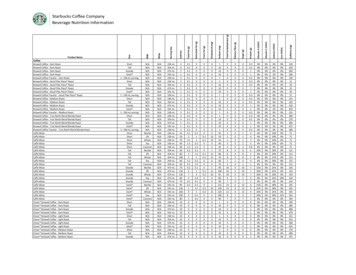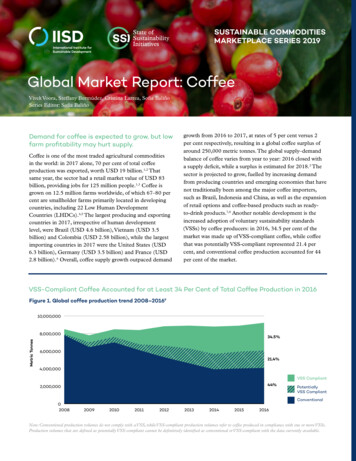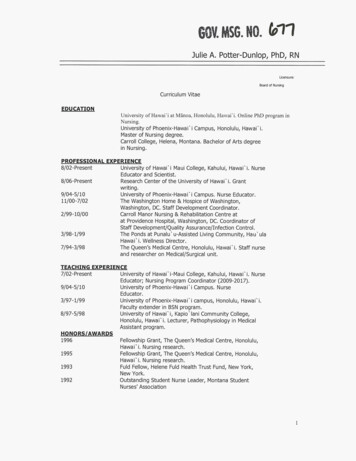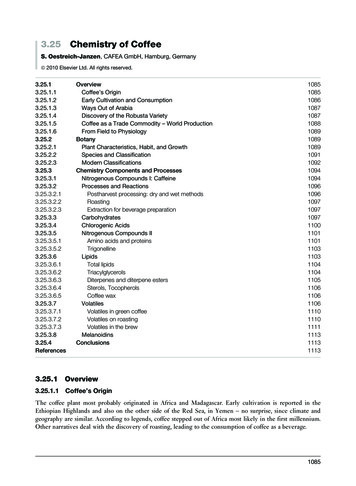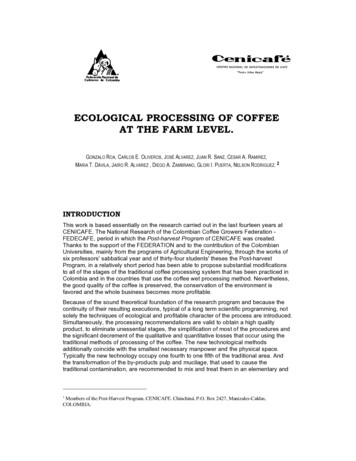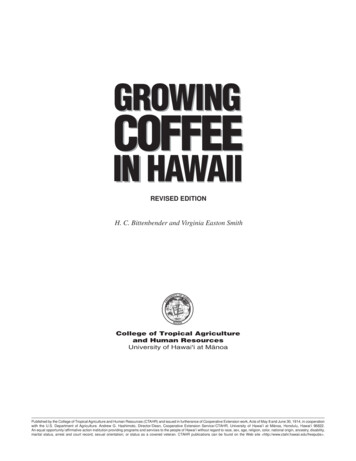
Transcription
GROWINGCOFFEEIN HAWAIIREVISED EDITIONH. C. Bittenbender and Virginia Easton SmithPublished by the College of Tropical Agriculture and Human Resources (CTAHR) and issued in furtherance of Cooperative Extension work, Acts of May 8 and June 30, 1914, in cooperationwith the U.S. Department of Agriculture. Andrew G. Hashimoto, Director/Dean, Cooperative Extension Service/CTAHR, University of Hawai‘i at Mänoa, Honolulu, Hawai‘i 96822.An equal opportunity/affirmative action institution providing programs and services to the people of Hawai‘i without regard to race, sex, age, religion, color, national origin, ancestry, disability,marital status, arrest and court record, sexual orientation, or status as a covered veteran. CTAHR publications can be found on the Web site http://www.ctahr.hawaii.edu/freepubs .
GROWING COFFEE IN HAWAIIAuthorsContentsH. C. ‘Skip’ Bittenbender, hcbitt@hawaii.edu , isan extension specialist in the CTAHR Department ofTropical Plant and Soil Sciences, UH-Manoa.Virginia Easton Smith, vsmith@hawaii.edu , is anextension agent in the same department, based at theKona Extension Office.Sources . 2Hawaii’s coffee industry today . 3Where and how to start a coffee orchard . 3Land Preparation . 7Selection of the nursery site . 11Which variety to plant? . 12The young coffee orchard . 14Irrigation . 17Weed control . 18Insect problems . 20Diseases and nematodes . 23Growth and fruiting habit of the coffee tree . 25Pruning . 26Harvesting . 32Yields . 34Processing . 35Selected references . 40Conversions from U.S. measure to metrics . 40About this publicationThe information contained in Growing Coffee in Ha waii is subject to change at any time and should beconsidered as suggestions only. To the knowledge ofthe authors, the information contained herein is accu rate as of March 2008. Neither the University of Ha waii at Manoa, the College of Tropical Agriculture andHuman Resources, the United States Department of Ag riculture, nor the authors or contributors shall be liablefor any damages resulting from the use of or relianceon the information contained in this book or from anyomissions to this book. Reference to a company, trade,or product name does not imply approval or recom mendation of the company or product to the exclusionof others that may also be suitable. The mention of apesticide material or commercial product or descrip tion of a pesticide use is in no way intended as an ex clusive endorsement or a substitute for restrictions, pre cautions, and directions given on the product label.Users of pesticides are responsible for making sure thatthe intended use is included on the product label andall label directions are followed.Updates to this information on coffee production willbe posted in the publications section of the CTAHRwebsite, www.ctahr.hawaii.edu, and the coffee sectionof the CTAHR Farmer’s Bookshelf, www.ctahr.hawaii.edu/fb. To obtain additional copies of this book,contact the CTAHR Office of Communication Services,3050 Maile Way (Gilmore Hall 119), Honolulu, HI96822; 808-956-7036; 808-956-5966 (fax); e-mailocs@ctahr.hawaii.edu. The Palehua Ohana Farmers Co operative, Naalehu, contributed funds in partial sup port of this publication.Copyright 1999, 2004, 2008College of Tropical Agriculture and Human Resources,University of Hawaii at ManoaISBN 1-929325-06-1January 2004 edition revised slightly, March 2008.2SourcesThe following commercial sources for various prod ucts mentioned in the text are provided for the conve nience of readers. Other suitable sources may also beavailable.Sudax (variety Dekalb-Pfizer Genetics SX-17 ):Hikiloa Co-op, PO Box 231, Hoolehua, HI 96729;808-567-6774; fax 808-567-6660.ZipSets (paper planting containers for raising seedlings):Monarch Manufacturing, Inc., 13154 County Road140, Salida, CO 81201; www.monarchmfginc.com .Spin Out (root growth regulator for plastic or paperplanting containers for raising seedlings): UnitedHorticultural Supply/UAP Pacific, Hilo, HI; 808 935-7191; www.nurserysupplies.com .Vegetable grafting clips: Fukuda Seed Store, 528Kaaahi St., Honolulu, HI 96817; 808-841-6719.Tractor-mounted rotary saw for stumping trees in me chanical pruning systems: TOL pruner (TOL Inc.,Tulare, CA).Coffee harvester currently in most frequent use in me chanically harvested coffee in Hawaii: Korvan Inc.,270 Birch Bay Lynden Road, Lynden, WA 98264;360-354-1500; www.korvan.com .Hand-held air-powered harvest aid: The Spidy . TheNew Farmer, 17655 Panama Ave. S, Prior Lake, MN55372; fax 612-440-6624; kumamn@aol.com .
GROWING COFFEE IN HAWAIIGrowing Coffee in HawaiiHawaii’s coffee industrytodayHawaii’s coffee industry is one of the mostdiverse and dynamic in the world. The cur rent technologies and production practicesspan a range of producers from 1-acre, certified organic,rainfed farms to 4000-acre, totally mechanized, irri gated plantations. Even the forests, and long-abandonedcoffee farms on most of the inhabited Hawaiian islands,yield harvests of feral coffee sown in the droppings ofbirds and pigs. Hawaii’s coffee production grew in re cent years from under 2 million pounds of green coffeebean in 1992 to 7 million pounds in 2003, with a farm gate value of 23.5 million. Hawaii’s coffee roastingindustry also ranges widely, from home roasters to“boutique” labels to full-scale industrial roast-and-grindmarketers. The retail value of the blended portion ofour roasting industry (roasted beans plus beverage sales)was valued at 117 million in 2002. The coffees growninclude a hybrid of ‘Mokka’, one of the most primitivelandraces from Africa; ‘Guatemalan’ (also called “Konatypica”), an early 19th century Central American landrace of Coffea arabica “typica”; and some of the mostmodern semidwarf cultivars from Brazil, including both‘Red Catuai’ and ‘Yellow Catuai’.This guide to cultural practices for coffee in Ha waii builds on CTAHR’s earlier publications by Y. BaronGoto and Edward T. Fukunaga, written in the 1950sand cited with the references (p. 40). New developmentsand changes in coffee production technology have oc curred both in the traditional “coffee belt” in Kona onthe island of Hawaii and in the new coffee-growing siteselsewhere in the state. This manual is designed both toserve the many new coffee farmers who need informa tion and to provide a “sounding board” for discussionof its contents and recommendations, which will aiddevelopment of a subsequent edition.Where and how to starta coffee orchardThe choice of a location to grow coffee inHawaii is simple if one lives in the Konaregion of the island of Hawaii, where soiland climatic conditions are ideal for coffee. But thequestion of where coffee can be grown is often askedby people whose interests extend across the state fromnorthwest Kauai to the southern tip of Hawaii. Condi tions differ widely over this range, and many factorsneed to be evaluated in consideration of the coffeeplant’s growth requirements.Coffee has been grown commercially for more than170 years in Kona, despite periods of adverse economicconditions. While coffee was grown earlier in otherlocations in Hawaii, it was not continuously cultivated,and coffee grown in areas other than Kona never at tained great importance until the 1990s.Many factors have contributed to the developmentof the Kona coffee industry. A historical one was thatlarge-scale agriculture, such as sugarcane or pineappleplantations and ranching, was more profitable elsewherein the islands. But the principal factor is that the cli mate of the Kona region is ideal for coffee. Its springand summer rainfall pattern is more favorable for cof fee growth than the winter rainfall normally receivedby much of the state. When rainfall coincides with warmtemperatures, the conditions are optimum for plantgrowth and fruit development in coffee and many otherfruit crops. Furthermore, Kona’s cool, dry winter is con ducive to maturing the coffee fruits (“cherries”) andforming flower buds for the next crop.In locations in Hawaii other than Kona where cof fee has been grown in the past, experience to guide theprospective grower is either scant or forgotten. Accord ingly, the prospective coffee grower outside Konashould proceed with care and caution.3
GROWING COFFEE IN HAWAII4TemperatureShadeTemperature is a key factor in coffee production, andthe strongest influences on temperature are latitude andelevation. Coffee is grown around the world at latitudesfrom 24 N to 25 S and elevations ranging from sealevel to as high as 7000 ft. In general, high-elevationcoffee regions are found in countries at or near the equa tor, such as Kenya, the New Guinea highlands, andColombia, while low-elevation coffee regions, such asHawaii and São Paulo, Brazil, are usually at subtropi cal latitudes (22–25 ). At any given latitude, coffee isoften grown over a wide range of elevations. In Ha waii, it seems that most elevations between sea leveland 2500 ft should be suitable for coffee, provided thatrainfall and soil factors are favorable.Coffee tolerates wide annual variations in tempera ture. In parts of Brazil’s São Paulo and Paraná states,coffee trees are injured by frost almost every year, andfreezes occasionally kill them. In the summer, how ever, coffee in these regions experiences very hot andhumid conditions. A more moderate climate for coffeeis found in one of the most important coffee-growingdistricts of Colombia, Chinchina, where the mean mini mum temperature is 60 F, the mean maximum is about80 F, and the mean monthly temperatures seldom varymore than 2–3 F throughout the year.High temperatures ( 90 F) before and during flow ering may result in abnormal coffee flowering and poorfruit set. In Kona (as in Brazil), the low winter tem perature and rainfall seem conducive to regular annualflowering. In Colombia, on the other hand, where tem peratures are neither too high nor too low and extremesare not encountered, dry periods seem to be of greatersignificance in affecting flowering.Cloudless, dry, high-temperature areas such asKekaha on Kauai or Waianae on Oahu are not favor able to coffee. However, successful coffee productionis found in low-rainfall areas at elevations as low as200 ft, such as Eleele on Kauai and Kapalua on Maui.In windward areas of Hawaii, Maui, Kauai, and Oahu,where rainfall is abundant and temperatures are rela tively constant, coffee flowering and harvesting sea sons may be more irregular and unpredictable than inKona, with its more pronounced seasonal conditions.In such windward areas, special crop management prac tices may be necessary for coffee production to be com mercially feasible.Shading with one or more layers of trees is practiced insome tropical coffee-growing areas, but in the subtrop ics of Hawaii and Brazil it has been found to be unnec essary. If an area is too warm for coffee, shade mighthelp. In the countries where shade is traditionally used,fertilizers are often in short supply, and the soil fertil ity is often inadequate to support a large crop. Underthese conditions, restricting light with shade reducesthe number of flowers per node, limiting productionand helping prevent dieback due to overbearing. Withadequate fertilizer and good management in Hawaii,however, high yields can be supported under full sunwithout dieback. Thus from the standpoint of coffeemanagement, there is little use for shade in Hawaii.From the environmentalists’ point of view, there is someinterest in having shade trees in Central American cof fee orchards to support bird populations—particularlymigratory birds from the U.S. mainland.WindCoffee should not be planted in sites exposed totradewinds or severe “kona” storms without a well es tablished windbreak. Wind bends young coffee trees,causing more vertical stems than desired to be produced,and this may reduce yield. Severe winds cause “cup ping,” tearing, and removal of leaves—and sometimesremoval of ripe cherries.Temporary windbreaks are essential for newlytransplanted trees in windy areas; a single row ofdensely sown Sudax, a sterile hybrid of sorghum andsudan grass, in the middle of the alley between coffeerows, is recommended (see Sources, p. 2). Sudax shouldbe planted at least six weeks before the coffee is trans planted and sown at a minimum rate of 2 lb/acre (nineseeds per foot of row, assuming the coffee rows are 12ft apart). If access by equipment during this establish ment period is essential, plant the Sudax closer to thewindward side of the coffee. Birds can be a problemduring germination. The windbreak should receive fer tilizer, and irrigation may be necessary. It should be 3–4 ft tall when the coffee is transplanted. After 18 months,when the coffee is 4 –5 ft tall, the Sudax can be killedby plowing or spraying a grass herbicide (this methodwas described by Osgood and Chang 1994; see Refer ences, p. 40).
GROWING COFFEE IN HAWAIICoffee hedgerows can serve to break wind veloc ity for the orchard, although severe wind-pruning willlikely occur in the rows exposed to wind intensity. Asystem of taller, permanent windbreak plants is pre ferred. A windbreak protects a downwind distance asmuch as 10 times its height. Some farms combine twotypes of tree windbreak. When the coffee trees areyoung, protection is provided by the tall, narrow, fastgrowing ‘Tropic Coral’ wiliwili (Erythrina variegata)planted 3–4 ft apart in rows 100–150 ft apart. As theorchard matures, it is protected by taller trees such asNorfolk Island pine (Araucaria excelsa) or a non spreading type of ironwood (Casurina cunningham iana) planted 6–8 ft apart in rows 600–800 ft apart.RainfallSome coffee-producing areas have annual rainfall ofonly 30 inches, while other areas receiving over 100inches of rain also have good production. Optimumannual rainfall for coffee in Hawaii is considered to be60–85 inches. However, the most important factor isthe rainfall distribution pattern as it relates to the vari ous phases in the coffee growth cycle: vegetativegrowth, flowering, maturing of coffee cherries, ripen ing, and harvesting. Excessive moisture stimulates veg etative growth at the expense of fruiting. If rainfall isuniformly distributed, flowering and fruiting will oc cur almost throughout the year. A short dry period, ide ally occurring during the coldest part of the year, helpsto synchronize the cropping cycle, inducing flower budgrowth by satisfying coffee’s requirement for dormancyprior to flowering.Irrigation is essential in Hawaii’s recently planteddry coffee-growing areas, such as Kaanapali on Maui,Eleele on Kauai, Kualapuu on Molokai, and Waialua onOahu. These areas are characterized by dry summersand wet winters, although the winters are not as wet as aKona summer. New orchards have also been planted inhigh-rainfall areas, along the Hamakua coast and in Punaon Hawaii and in Hana on Maui, where rainfall can ex ceed the optimum. So far, the coffee harvest in theseareas appears to coincide with the August–Decemberharvest season that is normal elsewhere in Hawaii.SoilCoffee grows best on deep, porous, well drained soils,especially those of volcanic origin. Soils with exces sively leached topsoil, impervious subsoil layers, orsolid rock close to the surface will not support healthycoffee trees. Coffee will not do well and can die onheavy soils if drainage is a problem or if the soil is keptcontinually waterlogged below the surface.Some soils in Kona and elsewhere in Hawaii areof recent origin and appear to be almost pure lava.Coffee does surprisingly well in such soils where therainfall is abundant and well distributed (or irrigationis available) and fertilizer is applied in proper amounts.Greater and more rapid leaching of fertilizers is ex pected in these locations, so applications must be lighterand more frequent.During drought on rainfed a’ä lava land, particu larly when the trees are bearing fruit, it may be impos sible to maintain healthy trees. The trees will sufferleaf dieback, lose fruit, and possibly die. This damagein dry years will be less likely to occur if the trees arewidely spaced and kept in optimum growing conditionby light and frequent fertilizer applications, pruning tomaintain only a few verticals, mulching, and control ling weeds.The Kona coffee beltDuring the past 100 years, experience has shown thatcoffee production is ideal in a narrow zone in Konaapproximately 20 miles long and 2 miles wide knownas the “coffee belt.” This “lower humid zone” runs al most parallel to the coast line. It begins in the north atPalani Junction and extends south to Puuhonua Road,and it lies between approximately 700 ft and 2000 ftelevation.The temperature in this area is ideal. At CTAHR’sKona Research Station in Kainaliu (1460–1670 ft el evation) in the heart of the coffee belt, the annual aver age temperature is 69 F, the average minimum is 60 F,and the average maximum is 78 F. The seasonal dropin temperature occurs simultaneously with drought,causing the coffee trees to slow their growth and de velop flower buds. The temperature for December,January, and February at the Kona Research Stationaverages 67 F (57 F minimum, 77 F maximum).Another characteristic of the coffee belt is an idealamount and distribution of rainfall, such that coffee inKona usually has not been irrigated. The annual rain fall averaged 68 inches historically, but since theKilauea volcano began erupting in 1983, it has beendrier, averaging 49 inches. The seasonal rainfall distri 5
GROWING COFFEE IN HAWAIIFigure 1. Average monthly rainfall, before and after the 1983 Kilauea volcano eruption, at the Kona Research Station in theKona coffee belt, compared with Eleele, Kauai, a major new coffee site.bution provides a short, dry period during the wintermonths that forces the coffee trees into a state of semi dormancy, which promotes a subsequent flowering.This dry period is followed by gradually increasing rain fall as the crop continues to maturity. As the harvestseason approaches, rainfall decreases, and the winterdry period begins the fruiting cycle again.During the low-rainfall period of December–Feb ruary, the last of the crop is harvested and the annualpruning is done. At the lower elevations of the coffeebelt, coffee trees appear to be on the verge of dyingfrom lack of moisture. But a week or two after the firstsoaking rain, usually in late February or March, budsthat have been forming during the dry, cool period willbloom. Three to four blossoming flushes take place inMarch–April, each following a heavy shower. As rain fall is intermittent and not too heavy during thesemonths, blossoming usually takes place on dry days,which, when followed by several additional dry days,ensures good fruit set. CTAHR research has demon strated that at a dry site on Oahu, coffee trees at theright stage of development can be forced to flower byapplying drip irrigation following an irrigation-free“drought.”6After mid-April in the coffee belt, rainfall increasesrapidly. High humidity and temperature promote rapiddevelopment of the current crop and the accompany ing vegetative growth that provides the foundation forthe next year’s crop. Around mid-September rainfalldecreases, facilitating harvest of the ripe cherries andslowing vegetative growth until semi-dormancy isforced by the cool, dry winter months.Evaluating areas forpotential coffee productionSelection of a suitable site for coffee planting on Kauai,Oahu, Molokai, or Maui, or in areas of the island ofHawaii other than Kona, should be made after carefulstudy of the particular location. The key questions toask are Will coffee yield a sufficiently large crop to justifythe financial outlay for planting? Will the crop be seasonal or be spread over the year? Can good quality coffee be produced in the area? Is any coffee being grown in the area, and will thegrower share experiences?
GROWING COFFEE IN HAWAIIObserving the condition of guava in the area is asimple way of determining whether or not coffee canbe expected to grow well. If guava plants appear healthyand bear abundant, juicy fruit, it is very likely that cof fee will do well. If the guava plants are sickly or stunted,it may be assumed that coffee will not grow well in thearea due to poor soil conditions or insufficient mois ture. If the guava plants are luxuriant with large greenleaves and succulent limbs but few fruits, it is possiblethat the area is too wet and cloudy for profitable coffeeproduction. If heavy rain continues for several daysduring the coffee flowering period, flowers will rot andthe crop will be small (this was the experience of plant ers in Olaa, near Hilo, at the turn of the 19th century).Indeed, if temperature and rainfall are not ideal at theflowering season (are too cold or too wet), many diffi culties may be encountered.Maps showing the suitability of lands in Hawaiifor coffee were generated by the CTAHR Hawaii Natu ral Resources Information System using a series ofstatements about the crop’s environmental require ments. The particular environmental aspects wereranked according to how difficult the condition is tocorrect. For example, it is hard to change the tempera ture, but soil moisture can be modified by irrigation.The computer mapping program used the followingstatements, listed in order from the most difficult tocorrect to the least difficult:A. Annual average temperature between 59 and 73 F.B. Good soil drainage, plus meets A.C. Land slope 28%, plus meets B.D. Soil pH of 4.5 –7.0, plus meets C.E. Annual rainfall 59 inches, plus meets D.From the maps (p. 8–9), one can see that most lands inHawaii meet the temperature conditions. Every islandhas land that meets all five conditions—480,000 acreson the Big Island, 54,000 on Kauai, 70,000 on Maui,39,000 on Oahu, and 2600 on Molokai. While the evalu ation does not consider current use or zoning, one cansee that coffee can grow in many areas of the state.Land preparationDuring land clearing for coffee, heavy veg etation and large rocks are removed. Wherethe land is not too rocky, clearing involvesthe removal of rocks, debris, and vegetation. After ini tial land preparation, collect a soil sample for analysis(follow the procedure in the CTAHR publication Test ing your soil: Why and how to take a soil sample, avail able from CTAHR Cooperative Extension Service of fices or from the web site http://www2.ctahr.hawaii.edu/oc/freepubs). The analysis will determine the need forsoil amendments that must be incorporated before plant ing, as well as any fertilizer nutrients that should beapplied before planting.After the vegetation has been cleared, map the area.Assistance in developing a soil conservation plan is avail able from the USDA Natural Resources ConservationService, 808-541-2600 ext. 101. Record the contours ofthe land and mark the tree spacing, windbreak locations,and approach roads to allow vehicles to enter and traversethe orchard. Roads within the orchard are essential inreducing costs of production. They facilitate delivery offertilizer, transportation of harvested coffee cherry, andmovement of sprayers for weed, insect, and disease con trol. Even where close coffee spacing is used, the instal lation of roads in the orchards between every fourth orfifth row of coffee trees to allow passage of vehicles isabsolutely essential. Coffee planted in hedgerows formechanical harvesting will require adequate roads atleast 20 ft wide at both ends of each row for turning.Where the land can be cultivated, fertilizer amend ments such as phosphorus and lime should be thor oughly incorporated into the soil by plowing and diskingseveral months before transplanting. If planting informer sugarcane or pineapple fields, rip any in-fieldroads to 20 inches depth, then rip the entire field. Ap ply lime and phosphorus in amounts recommended bythe soil analysis laboratory; at planting, the soil pHshould be 6. Then, cross-rip the field. Harrow the fieldto prepare for planting the windbreak rows. Rip againover the rows where coffee will be planted, then breakclods and level the soil with a rail (Osgood and Chang1994).Where the land cannot be plowed, holes must be dugor a trench must be ripped with a bulldozer. The holesshould be large and deep enough to allow plants to be7
GROWING COFFEE IN HAWAIIGrowing enviromments for coffee on five Hawaiian islandsThese maps were made with CTAHR’s Hawaii Natural Resource Inventory System, a geographic information systemdeveloped by the Department of Biosystems Engineering; the islands are not shown to scale.Not suitable, too hot or too coldA annual avg. temperature 59–73 FB A good soil drainageC B land slope 20%D C soil pH 4.5–7KauaiE D rainfall 59 inches,meets all coffee growth requirementsOahuMolokai8
GROWING COFFEE IN HAWAIIMauiHawaii9
GROWING COFFEE IN HAWAIItransplanted without bending the taproot. In formeryears, the practice was to place a handful of fertilizerhigh in phosphate (superphosphate or triple superphos phate) in the bottom of the hole, fill it completely withsoil, and allow the soil to settle for a month or so be fore planting. Where little soil was available, a shovel full of soil would be placed in the bottom of the holebefore planting to prevent injury of the roots by con tact with the fertilizer. Today, slow-release fertilizer tab lets are often placed on the side of the hole with lessdanger to new transplants.Planting distanceTraditionally, coffee trees were spaced at 8 x 8 ft or, incloudy areas, 10 x 12 ft. These wide spacings allowedthe trees to be kept low to facilitate picking and to ex pose a large surface of each tree to sunlight for increasedbearing. Many farms in Kona are still planted in thismanner, with spacing being determined by such fac tors as elevation (and its effect on sunlight and rain fall) and management practices.Recently, planting coffee in hedgerows has becomepopular, with the trees close together in rows separatedby wide alleys. This system increases the number oftrees per acre. In Kona, ‘Guatemalan’ coffee treespruned in the Beaumont-Fukunaga style (see p. 29) andhand-harvested may be spaced at 4–5 ft x 10–11 ft.This system also lends itself well to contour planting.In other areas, spacing of high-density plantingsof semidwarf cultivars (‘Caturra’, or ‘Catuai’) varieswith the means of harvesting. Spacing for mechanicalharvesting in Hawaii ranges from 2.5–3 x 12 ft; opti mum in-row spacing has not been determined, but itmay be 4 –6 ft, to reduce the need for pruning.An advantage of planting in hedgerows is lowerfertilizer and herbicide application costs. Instead ofapplying fertilizer around each individual tree, appli cation is made in a continuous band along either sideof each row, 1 ft or so away from the trunks of thetrees. Vehicle-mounted sprayers may be easily movedalong the rows in an orchard planted in hedgerows. Inirrigated orchards, soluble fertilizers can be applied withirrigation water.TransplantsCoffee orchards are started from transplants. Coffeeseeds are rarely planted directly into the orchard, pri 10marily because they germinate slowly, and weeds be come a problem. Growers have a number of options toobtain seedlings. For hand transplanting, these includegrowing plants in plastic bags or paper sleeves, grow ing plants in bed nurseries, and digging up volunteerseedlings (pulapula).Mechanical transplanting requires plants in bottom less paper sleeves or plastic dibbles. Standard mechani cal transplanters are used. Plastic containers must beremoved before transplanting; bottomless paper sleevescan be left on, although removing them encouragesroots to spread as soon as possible. Mechanical plant ing is usually done through plastic ground covers overdrip irrigation tubes.CTAHR researchers have found that tissue-culturedplantlets grow normally and are suitable for propaga tion. The Hawaii Agriculture Research Center is evalu ating the use of rooted cuttings.The recent appearance of the Kona coffee root-knotnematode (Meloidogyne konaensis; see p. 23–24) hascreated a need for caution in transplanting. Transport ing volunteer coffee seedlings to new planting sites canalso transport nematodes in their roots and should notbe done unless the soil of the orchard they are takenfrom has been assayed and declared free of the nema tode. When seedlings are grown in containers in mediathat includes soil, this also should be analyzed for thepresence of nematodes.For most situations, purchasing ready-to-plant seed lings is the most cost-effective alternative. Coffee treescan remain productive for 100 years provided they startas healthy, well grown seedlings. The money savedproducing your own seedlings will not pay for the pos sible cost of replanting an orchard, replacing dead trees,or even starting a nursery over again. We recommendbuying seedlings in paper sleeves or plastic bags, ready to-plant, from a nursery.Coffee intended for planting in an old or existingcoffee orchard in Kona should be grafted onto root stock of the species Coffea dewevrei if soil assay findsthe Kona coffee root-knot nematode. Some nurseriesmay be selling such grafted plants.Recommendation:Buy transplants from a nursery andbypas
and changes in coffee production technology have oc curred both in the traditional “coffee belt” in Kona on the island of Hawaii and in the new coffee-growing sites elsewhere in the state. This manual is designed both to serve the many new coffee farmers who need infor

